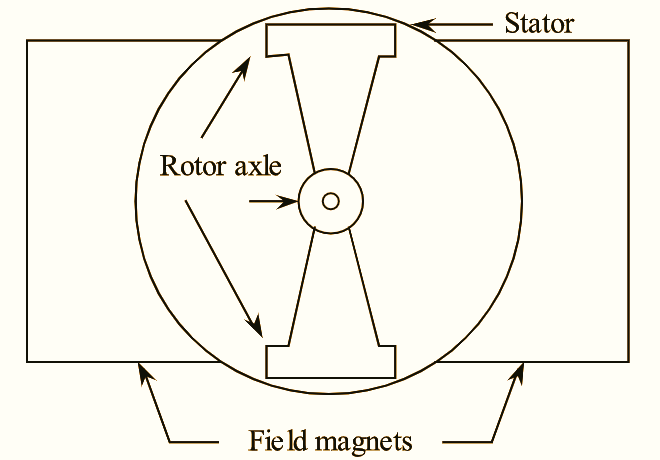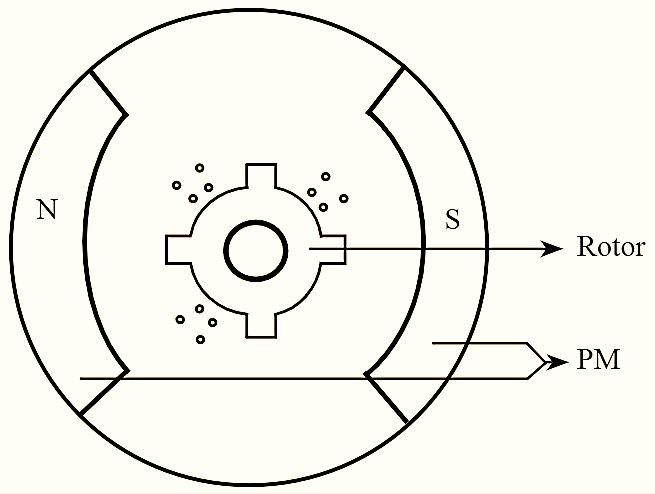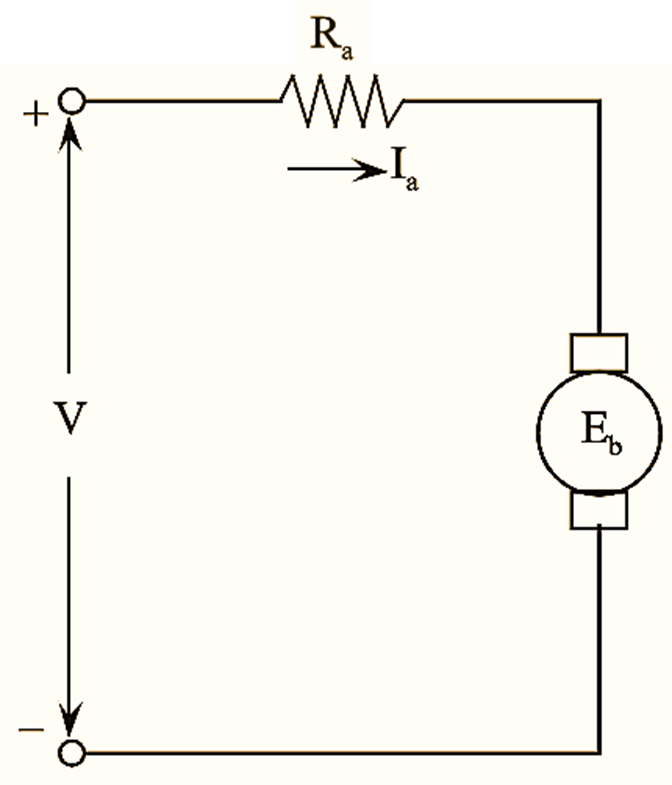Permanent magnet motors are similar to conventional DC motors except the use of permanent magnet to produce flux instead of field winding. The use of high energy permanent magnet in the motors which advances in the field for the purpose of simplicity and low initial cost has led to the formation of new class of motors known as permanent magnet motors.

Construction of Permanent Magnet DC Motor (PMDC Motor)
The design of Permanent Magnet DC motors (PMDC) is same as conventional DC motors. PIMDC motors are smaller and cheaper than other motors. Figure (l) shows the layout of PMDC motors.

Figure 2: Cross-section of PMDC Motor.
From figure (2), it is observed that the stator also provides alternative return path for magnetic material. The rotor consists of various slots for windings, brushes and commutation similar to conventional DC motors
Working Principle of Permanent Magnet DC Motor (PMDC Motor)
When the rotor rotates, the permanent magnets come into alignment with the field magnets and get attracted with the iron (or) steel core of the field magnets. The external magnetic field is produced by this high energy permanent magnets. The attraction of permanent magnets and the iron or steel core produces the torque without consuming power, this is known as ‘attraction phase’. When the rotor rotates and passes the centre of field magnets, a pulse is generated through the field magnet and the permanent field magnet will have same polarity which makes the permanent magnet to repel.
Now, the magnetic field is produced by the field magnets and this magnetic field in combination with the magnetic flux of the permanent magnet produces a torque. For this, power is consumed only for a small (i.e., millisecond) period of time.
This is known as ‘repulsion phase’. As most of the work is done by permanent magnets, so very low power is consumed and hence, the power required to run the motor is very low making the motor highly efficient.
Equivalent circuit of Permanent Magnet DC Motor (PMDC Motor)

Figure 1: Equivalent circuit of PMDC Motor.
Permanent magnet DC motors are similar to normal DC shunt motor, the only difference is that they consist of permanent magnets for producing magnetic flux instead of stationary field winding. By the interaction of flux produced by permanent magnet and armature current, the torque is developed in motor. The equivalent circuit of permanent magnet DC motor is shown in figure. In this circuit, the field winding connection is absent due to permanent magnet. This circuit also helps in analyzing the operation of motor.
Let,
V – DC source voltage
Ia – Armature current
Ra – Armature resistance
Eb – Back e.m.f
K – Constant
N – Speed in r.p.m
n – Speed in r.p.s
P – number of poles
ω – Angular motor speed
T – Torque
A – Number of armature poles
Z – Number of armature conductors
ϕ – Flux per pole.
From the fundamentals, the relation between speed and back e.m.f is given by,
\[{{E}_{b}}=\frac{\phi ZNP}{60A}\]
\[=\frac{\phi ZnP}{A}\text{ }\left[ \begin{align}
& N=60\times n(\text{in r}\text{.p}\text{.s}) \\
& n=\frac{N}{60} \\
\end{align} \right]\]
But we have,
\[\omega =2\pi n\]
\[n=\frac{\omega }{2\pi }\]
\[{{E}_{b}}=\frac{\phi ZP}{A}.\frac{\omega }{2\pi }\]
\[{{E}_{b}}=\frac{\phi ZP}{2\pi A}\omega \]
As flux ‘ϕ’ is constant in case of permanent magnet DC motor, thus we have,
\[K=\frac{\phi ZP}{2\pi A}\]
\[{{E}_{b}}=K\omega …(1)\]
We have a torque equation in terms of current for DC motor as,
\[T=\frac{\phi ZP}{2\pi A}{{I}_{a}}\]
\[=K{{I}_{1}}\]
Also, the supply voltage of motor is given by,
\[V={{E}_{b}}+{{I}_{a}}{{R}_{a}}…(2)\]
Substituting equation (1) in equation (2), we get,
\[V=K\omega +{{I}_{a}}{{R}_{a}}\]
\[K\omega =V-{{I}_{a}}{{R}_{a}}\]
\[\omega =\frac{V-{{I}_{a}}{{R}_{a}}}{K}\]
Hence, by using equivalent circuit and equations, the performance and operation of permanent magnet DC motor can be analyzed.
Advantages of Permanent Magnet DC Motor (PMDC Motor)
- Manufacturing cost required is less.
- Size is small.
- Efficiency is high.
- Noiseless operation.
- Speed control is simple.
- High dynamic response.
- Reliability is high due to mechanical commutator.
- Better speed-torque characteristics.
Disadvantages of Permanent Magnet DC Motor (PMDC Motor)
- PMDC motor can be demagnetized by armature reaction m.m.f, which in tum makes the motor inoperative.
- If these motors are used for long periods, then their temperature tends to be higher as compared to wound field motors.
- Need regular maintenance for brushes and commutator.
- Density of power is medium.
Applications of Permanent Magnet DC Motor (PMDC Motor)
Some of the of permanent magnet DC motors are listed as follows.
- Air-conditioning systems
- Auto bank machines
- Bar code readers at supermarkets
- Ticketing machines
- Washing machines
- Vacuum cleaners
- Blowers
- Computer disc drives
- Automobiles staffer
- Cloth drives
- Industrial drives
- Toys and wipers
- Machine tools
- Kitchen appliances
- Optical equipments etc.
Difference between PMDC Motors and DC Motors
The differences between PMDC motors and DC motors are as follows,
PMDC Motor | DC Motor |
| PMDC motor uses permanent magnetic field system. | Conventional DC motor uses electromagnetic field system. |
| It works on the principle of Faraday’s laws of electromagnetic induction i.e., whenever a current carrying conductor is placed in a magnetic field, it experiences a force. | It consists of a stationary field system to produce the main magnetic flux by exciting the winding on the body. |
| Efficiency is high. | Efficiency is low. |
| Field copper loss is less. | Field copper loss is high. |
| Space required by the motor is small. | Space required by motor is more. |
| Effective air gap is large. | Effective air gap is less. |
| Distortion of the magnetic field is eliminated. | Distortion of the magnetic field is high. |
| Commutation is high. | Commutation is less. |
| Effect of armature reaction is less. | Effect of armature reaction is high. |
| High overload capacity. | Minimum overload capacity. |
| Responds very fastly to the changes in current. | Responds slowly to the changes in current. |
| Operation of the motor above base speed is not possible. | Operation of the motor above base speed is possible. |